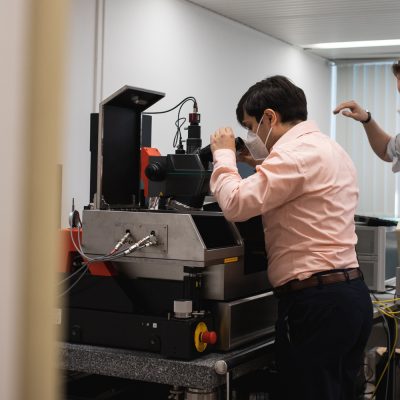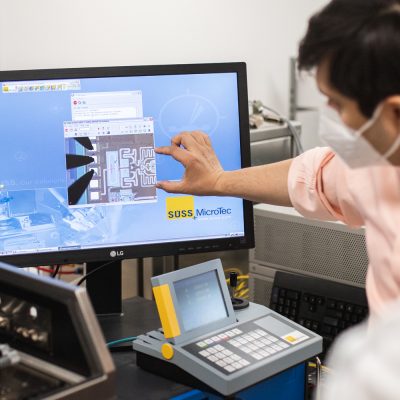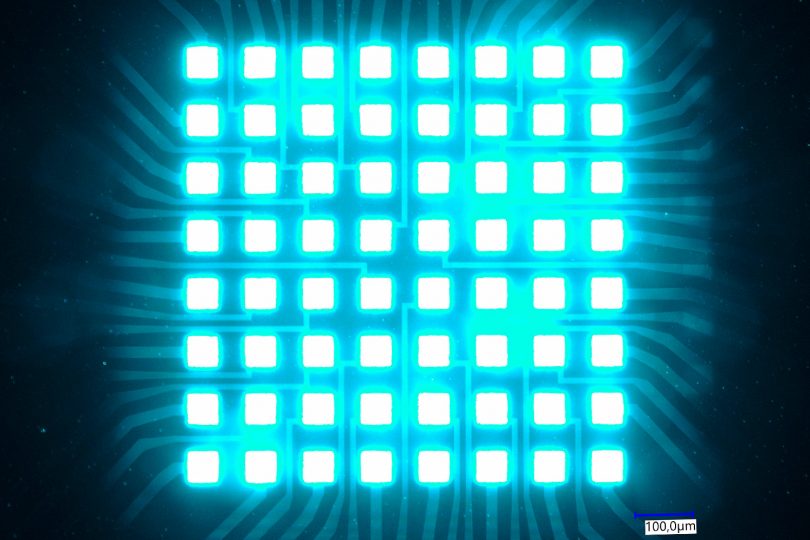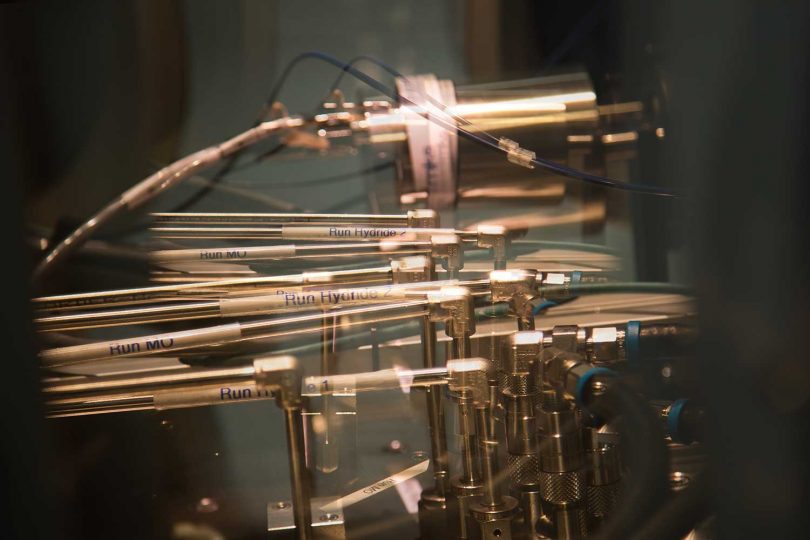Master of miniaturisation Why scalability wins the quantum race
Quantum Valley Lower Saxony (QVLS) aims to build a scalable quantum computer by 2025. The emphasis here is on the word “scalable”. The first quantum computers already exist. However, it is extremely complex to increase their computing power without expanding the computer to the size of a gymnasium. One of the keys to the QVLS for the scalable quantum computer therefore lies in the Institute for CMOS Design at Technische Universität Braunschweig.
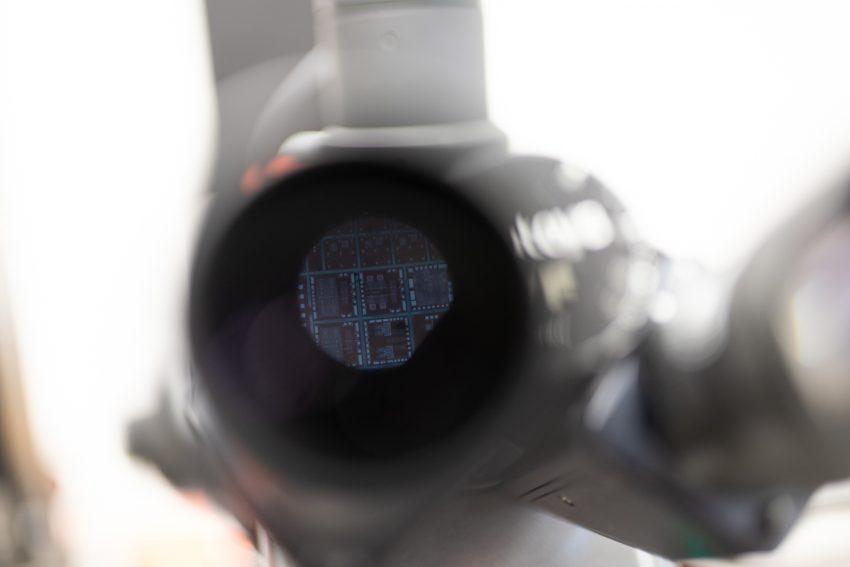
Technology in the tiniest of spaces: a view through the microscope shows the fine details of a chip. Photo credit: Max Fuhrmann/TU Braunschweig
In 2019, Google’s Sycamore quantum processor solved a task in a matter of minutes that would have taken a conventional supercomputer perhaps 10,000 years. The reason for this is the special architecture of quantum computers, which makes different solutions possible. Computing power increases with each quantum bit, or qubit. “Sycamore had just 53 qubits at its disposal when it achieved its milestone. The idea of one day combining millions of qubits in a single device has given rise to visions of the future. For example, quantum computers could revolutionise the search for new materials or medicines.
But the special architecture of existing quantum computers is also their Achilles’ heel. On the one hand, it takes up space. IBM’s computer with 25 qubits, for example, takes up 27 cubic metres. On the other hand, qubits are currently short-lived and, depending on the type of quantum computer, can be faulty. This is a problem that cannot be solved even with more qubits. This is because if one qubit is faulty, several other qubits are needed to correct the error. A computer with more qubits, but a high probability of error, therefore has hardly any more computing power.
Stable and scalable
Quantum Valley Lower Saxony (QVLS) focuses on exactly these two aspects: Scalability and fault tolerance. To ensure the latter, the network’s more than 400 scientists are primarily researching an ion trap quantum computer. Trapped ions in a vacuum are particularly stable qubits, even at room temperature. The researchers use microwave pulses to control the sealed qubits.
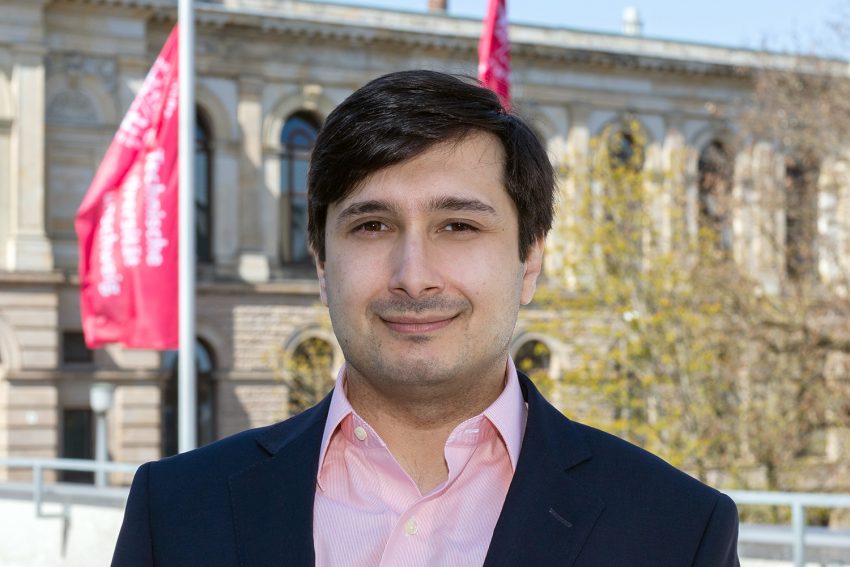
Professor Vadim Issakov heads the Institute for CMOS Design at TU Braunschweig. Photo credit: Max Fuhrmann/TU Braunschweig
“The circuits for the qubits are the key to scalability,” explains Vadim Issakov, Professor of CMOS Design at TU Braunschweig. “At the moment, the pulse-generating components take up half a room. If we replace them with integrated circuits, i.e. chips, it suddenly becomes very compact: a component no longer needs half a square metre, but only nine square millimetres.
Between basic research and technology transfer
As head of the new Institute for CMOS Design, Professor Issakov is conducting research at the interfaces of the Lower Saxony Quantum Alliance. On the one hand, there are alliances such as the Cluster of Excellence QuantumFrontiers, which, together with Leibniz University Hannover and the Physikalisch-Technische Bundesanstalt, is researching the fundamentals of the quantum world. On the other hand, there are industrial partners who ultimately want to use quantum technologies commercially.
Professor Vadim Issakov: “CMOS semiconductor technology is the way forward. We are using it to transfer the successes of basic research into applications needed by industry. Large, self-developed laboratory devices are thus transformed into tiny chips suitable for industrial production.”
- Photo credit: Max Fuhrmann/TU Braunschweig
- Photo credit: Max Fuhrmann/TU Braunschweig
BMBF project QuMIC
One example of this collaboration is the QuMIC (Qubit Control by Microwave Integrated Circuits) project. In addition to TU Braunschweig, Leibniz University Hannover and the Physikalisch-Technische Bundesanstalt (PTB), QuMIC also includes the technology companies Infineon Technologies and Supracon. The collaboration’s innovative BiCMOS chips are intended to make the control electronics of quantum technologies such as ion trap computers eight times smaller. The Federal Ministry of Education and Research is providing QuMIC with 4.4 million euros over three years from 1 September. With its share of almost one million euros, the Institute for CMOS Design will then develop the chips, which in turn will be installed in ion trap computers by PTB researchers.

